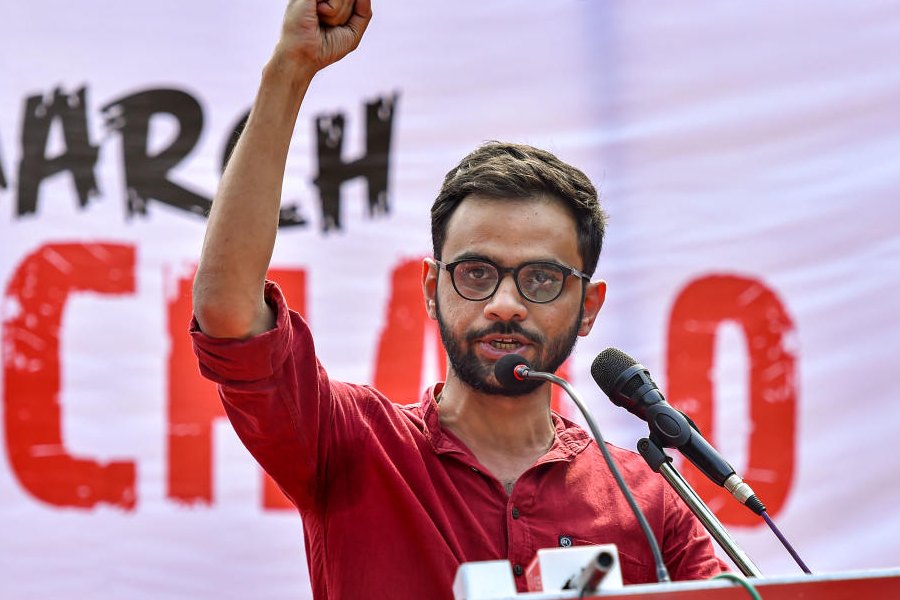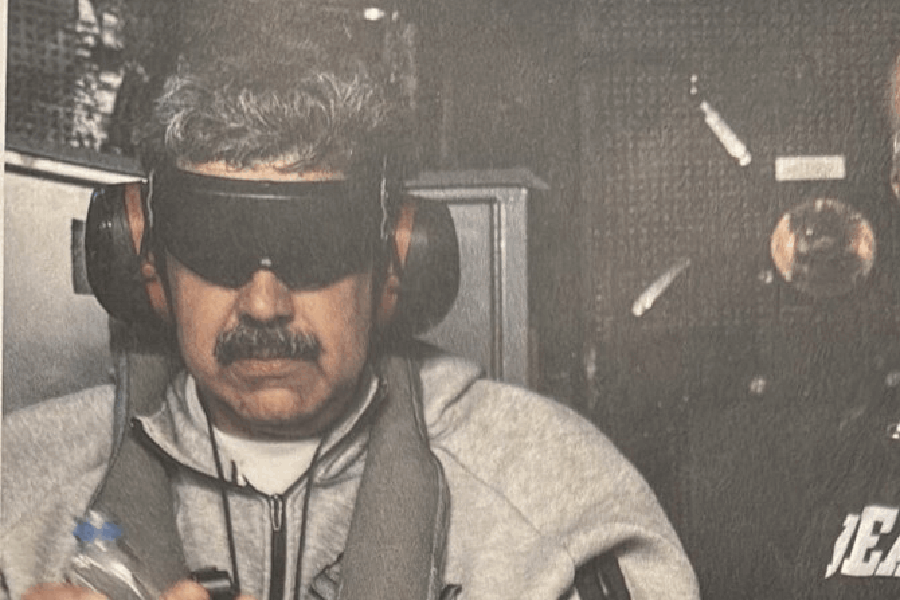‘Mera shohar banne ki koshish mat karo. Biwi ho, biwi ki jagah pe raho.’
(Don’t try to become my husband. You are the wife, behave as one.)
– JK to Aarti, Aandhi (1975)
‘Meera, ghar ki bahu ki tarah maryada mein raho.’
(Meera, conduct yourself with the decorum becoming of a daughter-in-law.’
– Raja Bhojraj to Meera, Meera (1979)
Though separated by close to five centuries, it is possible to see a real-life medieval king, Bhojraj (Vinod Khanna in Meera), and a fictional hotel manager, JK (Sanjeev Kumar in Aandhi), as part of a continuum, almost mirror images of each other in the way they are pitted against women of substance, in their essentially patriarchal outlook (though they are not monstrous chauvinists in any way) and in the way they come to realise that their spouses are more than only that. In the lines quoted above, Gulzar proffers an insight into the ‘default’ mindset of even the best of men – one that was true as much in the era of Meera in the late 1400s, as it was during the Emergency in 1975 and as it is today.
The depiction and representation of women in Hindi cinema have been ‘problematic’, to put it mildly. Interestingly enough, the 1930s were marked by a progressive attitude to women in Hindi cinema – with stalwarts like Devika Rani, Durga Khote and Mary Ann Evans aka Fearless Nadia and films like Duniya Na Mane and Achhyut Kanya. However, it was not long before women were relegated to mere appendages for the most part. The portrayal of women too languished, with Shyam Benegal memorably describing it as, ‘Her virtue [lies] in being the good mother, wife, sister — a set of essential roles a woman has to play — which is a terrible kind of oppression; a glorification not allowing the woman any choice.’
Even in the 1950s, a decade of enlightened filmmakers, iconic women characters in some of the most talked-about films of the era – Mother India, Pyaasa, Mr and Mrs 55 – adhered to these constructs, the all-sacrificing mother, the courtesan with a golden heart who needs the man to provide her dignity, or the free-spirit/tomboy who has to be taught to be feminine enough (The Taming of the Shrew being a favourite film trope for most of the 1960s and ’70s).
Jaya, Hema and Sharmila; Rekha, Dimple and Tabu…
Gulzar broke through this clutter. Eleven of the 17 films he has directed feature a woman as the primary protagonist. The rest, barring possibly Kitaab and Angoor, have women in pivotal roles. That says a lot about a filmmaker operating in what were possibly the worst decades in Hindi cinema vis-à-vis the representation of women. As does the fact that glamorous mainstream stars like Jaya Bhaduri (Parichay; Koshish), Hema Malini (Khushboo; Kinara; Meera), Sharmila Tagore (Khushboo; Mausam; Namkeen), Rekha (Ghar; Ijaazat), Dimple Kapadia (Lekin) and Tabu (Maachis; Hu Tu Tu) had their finest roles in films he has been involved with.
Gulzar’s breakthrough in cinema – as a lyricist in Bandini (1963) – came about with a song that’s a triumph when it comes to conveying feminine desire. Couched in the tradition of a Vaishnav bhajan, ‘Mora gora ang lai le’ is as much a metaphor for a young women’s sexual awakening, the first frisson of being in love. There is probably no other song that merges the corporeal with the metaphysical as seamlessly. A young girl on a secret tryst to meet her beloved, seeking the night’s cover of darkness, as also a comment on a devotee’s desire to become one with God, in this instance the dark-skinned Shyam. For a culture that values ‘fair skin’ above everything else, it is quite extraordinary how the song articulates a woman’s desire to embrace ‘Shyam-rang’ for the sake of love.
At the same time, when called upon to articulate the raw eroticism of desire, Gulzar could be as explicit as he is in Basu Bhattacharya’s Aastha:
Labon se choom lo aankhon se thaam lo mujhko
Tumhi se janmoon toh shaayad mujhe panaah miley…
This understanding of the feminine psyche is also evident in the sensual and playful songs that he wrote for Anubhav – ‘Koi chupke se aake’, ‘Mera dil jo mera hota’ and ‘Mujhe jaan na kaho’. Or for that matter ‘Pehchan toh thi’ in Griha Pravesh, a rare sensitive take, in Hindi cinema, on adultery that he also wrote. Then there’s Rudaali, where the impossibility of Shanichari’s yearning finds a most evocative outlet in ‘Dil hum hum kare’. The film, written by Gulzar, based on a short story by Mahasweta Devi, is a landmark in the representation of women in Hindi mainstream cinema, highlighting gender inequality and patriarchy against the backdrop of class and caste divides, with scholar Priya Kapoor calling it ‘a feminist treatise on solidarity against caste ostracisation and the plight of the subaltern woman at the hands of landowning classes’.
The memorable Aarti Devi, literally the only woman in Aandhi
Right from his debut as director, Mere Apne, Gulzar’s films have featured an array of memorable female characters, drawn with empathy. Aandhi of course boasts one of Hindi cinema’s most memorable female characters, Aarti Devi, played by Suchitra Sen. Here is an unapologetic look at a woman who marries for love and discovers that she is not cut out for domesticity. Unlike most other women in films of the era, she prioritises her own needs, her career, over her husband, even her child. And her choice of profession too says a lot – a politician, an arena that has for the longest time been a male preserve. It is fascinating that Aarti is, literally, the only woman in the film – and yet she is the pivot around whom the narrative revolves.
The other exceptional woman in politics in a Gulzar film is Maltibai (Suhasini Mulay) in Hu Tu Tu, again an interesting exposition of a woman’s tryst with power and its corrupting influence.
Mausam did in 1975 what Lamhe attempted in 1991
If Aarti is a political worker in Aandhi, Kajli (Sharmila Tagore) in Mausam is a worker too. If Aarti does not regret her choice of career, there is none of that in Kajli either, even though she is a sex worker. It’s a no-holds-barred portrayal that steers clear of the cliches that characterised leading stars playing women of disrepute in Hindi cinema. Of course, there’s the element of change that comes over her with her growing affection for the elderly doctor, but that is never overtly underscored. The man here is not on a mission to uplift her. And if Lamhe was seen as ahead of its time, even in 1991, in the way it depicted a woman’s feelings for a man who was her mother’s lover, it is worth considering that Mausam did this as early as in 1975.
Playing Kusum in Khushboo changed my image: Hema Malini
The other Gulzar film in 1975 (a remarkable year for the filmmaker) that went against the grain in the way it framed its woman protagonist is Khushboo. Feminists may have a problem with the basic narrative where the woman, Kusum (Hema Malini), seems to be doing nothing but pining for the love of a man, Brindaban (Jeetendra), who has not treated her very well, though he too is a victim of the ways of destiny. In Gulzar’s vision, however, Kusum emerges as a woman with dignity, one who is self-assertive and refuses to be taken for granted.
This comes across most memorably in her exchange with Brindaban’s mother (Durga Khote). ‘Chhodi hui ladki ko koi wapas le le, is se bada maan kya milega usey? (What greater respect for a girl who has been forsaken than being offered marriage),’ she tells Brindaban. But Kusum brings up the very important aspect of her desire and consent. As she tells her friend, ‘Koi raaste par thodi baithi hoon, jab jee chahega chhod jayenge… meri marzi kuch nahin? (Isn’t my opinion important? I am not some destitute you take home or abandon as you please).’ And in the definitive act of self-assertion, she returns the bangles that the mother patronisingly gives her as a token of her impending marriage to Brindaban. She, however, does this without in any way humiliating the mother. She affords her the respect she deserves.
Gulzar’s choice of Hema Malini in the lead also demonstrates his ability to cast against type. The actor was at the time the superstar of Hindi cinema, the ‘dream girl’ who epitomised the glamour and kitsch that were the hallmarks of Hindi film heroines of the era. Like he did with Sharmila Tagore (another glamorous star) in films like Mausam and Namkeen, Gulzar gave Hema Malini a makeover in the three films that are considered her finest: Khushboo, Kinara and Meera. As the star herself said, ‘I was too young to realise what kind of a strong character I was playing in that film (Khushboo), but this changed my image. I didn’t have to wear bell-bottoms and fancy wigs or run around trees.’
Main bhavna hoon, kisi samaj ka vichar nahin: Meera
Of these three films, Meera best articulates the director’s political and feminist stance. Gulzar’s triumph in Meera lies primarily in the way he strips the highly mythologised religious character of overt mysticism so that she becomes contemporary, timeless. Gulzar’s Meera is a woman with a mind of her own, through whom the director addresses the hypocrisy of religious institutions and dogma as also aspects of secularism and statecraft.
Most of these arguments come across in the debates Meera has with the head priest (played by Om Shivpuri). He pontificates about the importance of Karwa Chauth and says, ‘Pati hi tumhara Parmeshwar hai (Your husband is your God).’ She responds, ‘Parmeshwar hi mera pati hai (Yes, God is my husband).’ The exchange turns on its head Hindi cinema’s fixation with the concept of ‘pati-parmeshwar’ while also driving home the point that Meera, the devotee, considered herself betrothed to Lord Krishna.
There is also a strong political awareness that Gulzar imbues Meera with. She dresses Krishna as a Rajput, reasoning ‘Jaisa desh waisa bhesh’ (when in Rome do as the Romans do). She addresses the subject of caste in her relationship with poet-saint Raidas (A.K. Hangal). She even engages with Emperor Akbar (Amjad Khan), chiding him for keeping Tansen ‘bound’ to the court. Gulzar’s Meera actually provides the last word on shallow nationalism when she tells the head priest: ‘Aap apna desh bas wahin tak maante hain jahan tak aapka raajpaat chalta hai. Aapka desh kabhi ghat jaata hai, kabhi badh jaata hai. Main aapki seema ko apne desh ki seema nahin maanti.’ (Your notion of a country is confined to the land you govern. It waxes and wanes according to the territory you control. I am not bound to the boundaries you set for your state.)
And when she is finally put on trial for failing in her duties as a chaste woman, failing to do what her family and society expects of her as a wife, she provides the most eloquent statement of her identity as a woman: ‘Main atman hoon, sharir nahin, main bhavna hoon, kisi samaj ka vichar nahin, main premi hoon, premika hoon, kewal prem naam ki jogan, kisi sambandh ki kadi nahin, kisi parivaar ki khuti se bandhi nahin.’ (I am the soul, not the body. I am an emotion, not a social construct. I am a lover, a mendicant of love, not a link to a relationship. I am not bound to the peg of a family.)
Maya in Ijaazat is unlike any woman in Hindi cinema
Films like Namkeen and Ijaazat are remarkable for the variety and depth of women characters they offer. In Amma, Nimki, Mithu and Chinki and their cloistered ramshackle world, Namkeen is an almost Chekhovian take on women. Maya in Ijaazat is unlike any woman in Hindi cinema – impetuous, a free spirit who loves fiercely and without condition, who lives life on her own terms, offering a contrast to the other woman in the narrative, Sudha. As Saba Bashir observes in her book, I Swallowed the Moon, ‘The film explores an extramarital relationship without either woman being projected either as conniving or as a victim.’ Though the male protagonist, Mahender (Naseeruddin Shah), is the one in a relationship with both at different times in his life, it is Maya and Sudha who, even if they never meet, share a special bond. It is a camaraderie born out of being women.
Lekin… Libaas… Ghar
In Lekin, a woman who ‘travels across lifetimes in search of salvation’ becomes the conduit for the man’s exploration and understanding of his own self. And of Libaas, the unreleased film, based on a short story, ‘Seema’, written by Gulzar himself, Saba Bashir writes, here’s ‘a woman seeking not only happiness in a marriage but also stability and fulfilment in relationships’. There’s also Ghar, a film that addresses the subject of rape with a sensitivity that is astounding for its time. Though Manik Chatterjee is credited as its director, it is well known that he suffered an accident during the making. It is Gulzar who completed the film and the final product bears the master’s unmistakable stamp.
Almost all these women stand out for their fortitude, their independence and dignity, and their empathy. But what sets apart Gulzar’s unerring eye for the feminine is that even when the women are less than perfect – for example, the selfish relative in Mere Apne, the unfaithful wife in Achanak, the sister-in-law in Meera and the manipulative politician in Hu Tu Tu – there is no value judgement being made. They are characters of flesh and blood, never caricatures.
And with humour being an integral part of Gulzar’s cinematic oeuvre, what better homage to the power of women than this song from Swayamvar which not many might associate with the legend:
Naari kuch aisan aage nikal rahi hai
Mardan ke paon taley dharti phisal rahi hai
Shantanu Ray Chaudhuri is a film and music buff, editor, publisher, film critic and writer











